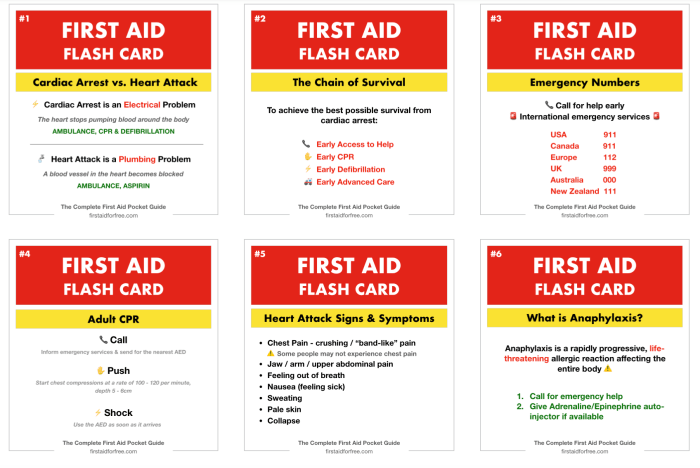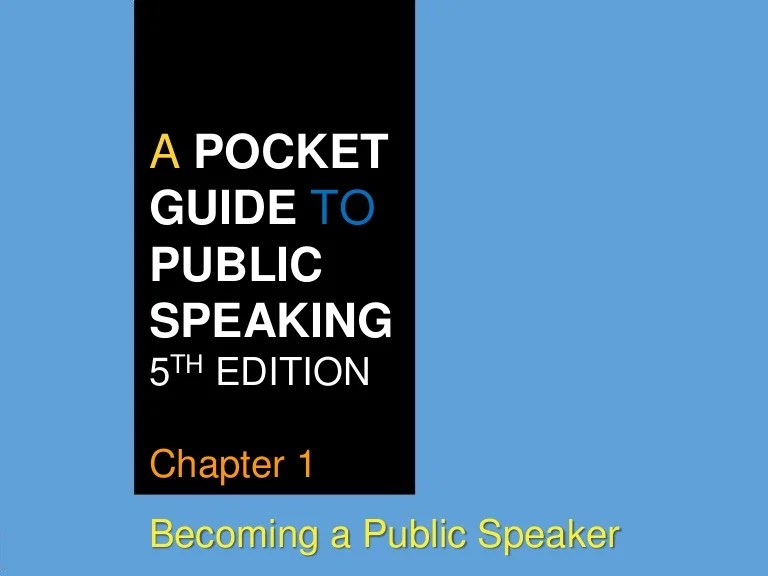Introducing the pocket guide to public speaking PDF, an indispensable resource designed to empower you with the knowledge and techniques to deliver captivating and impactful presentations. This comprehensive guide is your go-to companion, providing you with a wealth of practical tips, strategies, and insights to elevate your public speaking skills.
Whether you’re a seasoned speaker or just starting out, this guide is tailored to meet your needs. Its user-friendly format and accessible language make it an invaluable tool for anyone looking to enhance their communication abilities.
Introduction to Pocket Guide to Public Speaking
A pocket guide to public speaking serves as a compact and accessible resource, offering practical guidance and essential techniques for effective communication in public settings. This guide is designed to empower individuals with the knowledge and skills necessary to navigate the challenges of public speaking confidently and successfully.
The target audience for this pocket guide encompasses anyone seeking to enhance their public speaking abilities, including students, professionals, business leaders, and aspiring speakers. It is particularly beneficial for those who frequently engage in presentations, speeches, or other forms of public communication.
Essential Elements of a Pocket Guide to Public Speaking
A pocket guide to public speaking should provide the essential information and techniques that speakers need to deliver effective presentations. The guide should be concise, easy to follow, and packed with practical tips and examples.
Key Components and Sections
The following components and sections are essential for an effective pocket guide to public speaking:
- Introduction:Provides an overview of the guide and its purpose.
- Preparing Your Speech:Covers the steps involved in developing and organizing a speech, including choosing a topic, researching, and writing an Artikel.
- Delivering Your Speech:Offers guidance on vocal delivery, body language, and audience engagement.
- Managing Nervousness:Provides techniques for overcoming stage fright and delivering a confident presentation.
- Troubleshooting:Addresses common challenges that speakers may face, such as handling difficult questions or technical difficulties.
- Additional Resources:Includes a list of recommended books, websites, and other resources for further learning.
Importance of Clear and Concise Language, Examples, and Practical Tips
The language used in a pocket guide to public speaking should be clear and concise, avoiding jargon and technical terms. Examples should be used to illustrate key concepts and make the guide more relatable to readers. Practical tips should be provided throughout the guide to help speakers apply the techniques discussed.
Examples of Effective Pocket Guides
Here are a few examples of effective pocket guides to public speaking:
- “The Pocket Guide to Public Speaking” by Dale Carnegie
- “Speak with Confidence: A Pocket Guide for Effective Public Speaking” by Carol Fleming
- “The Quick and Easy Guide to Public Speaking” by Michael Butterworth
Structuring the Guide for Maximum Impact

The structure of a pocket guide to public speaking plays a pivotal role in maximizing its impact and usability. A well-organized guide provides a clear roadmap for readers, enabling them to navigate the content effortlessly and find the information they need quickly.
Logical Sections
Organize the guide’s content into logical sections that follow a coherent progression. Consider dividing the guide into distinct parts, such as:
- Introduction: Provide an overview of public speaking and its benefits.
- Preparing a Speech: Cover topics such as choosing a topic, researching, and structuring the speech.
- Delivering a Speech: Address techniques for effective delivery, including vocal projection, body language, and visual aids.
- Handling Questions and Feedback: Discuss strategies for fielding questions and managing constructive criticism.
Headings, Subheadings, and Bullet Points
Enhance readability by using headings and subheadings to break down the content into smaller, manageable chunks. Headings should be clear and concise, reflecting the main topics covered in each section. Subheadings can further organize the content within sections.
Bullet points are an effective way to present key points, tips, or examples in a concise and easy-to-read format. Use bullet points sparingly, reserving them for essential information that warrants emphasis.
Examples of Well-Structured Guides
Refer to reputable pocket guides to public speaking for inspiration on structuring your guide. Examples include:
- “The Pocket Idiot’s Guide to Public Speaking” by Laurie Rozakis
- “The Complete Idiot’s Guide to Public Speaking” by Dianna Booher
- “Public Speaking for Dummies” by Christopher Steagall
Content Development

Effective content development is the cornerstone of an engaging and informative pocket guide to public speaking. Here are some tips and techniques to consider:
First and foremost, focus on crafting content that is relevant to your target audience. Understand their needs, interests, and knowledge level. Tailor your content accordingly to resonate with them effectively.
Storytelling
Storytelling is a powerful tool that can help you connect with your audience on an emotional level. Share personal anecdotes, relatable stories, or case studies to illustrate your points and make them more memorable.
Humor
Humor can be a great way to lighten the mood and engage your audience. However, use humor sparingly and appropriately to avoid distracting from your main message.
Personal Anecdotes
Personal anecdotes can help you establish a connection with your audience by making your content more relatable. Share experiences that highlight the importance of public speaking skills or illustrate the challenges you have faced.
Memorable and Actionable Takeaways
Conclude your guide with a summary of the key takeaways. These takeaways should be concise, actionable, and easy to remember. Encourage your readers to apply these tips in their own public speaking endeavors.
Visual Elements and Design Considerations
Incorporating visual elements such as images, graphs, and charts is crucial for enhancing the readability, comprehension, and engagement of a pocket guide to public speaking. Visuals break up text-heavy content, making it more accessible and visually appealing to readers.
Design principles for creating a visually appealing and user-friendly guide include:
Color and Typography
- Use a consistent color scheme throughout the guide to create visual unity and brand recognition.
- Choose legible and contrasting fonts for headings, subheadings, and body text to ensure readability.
Layout and Organization
- Organize content logically using headings, subheadings, and bullet points to improve navigation.
- Use white space effectively to separate sections and enhance readability.
Examples of Effective Visual Elements
- A pocket guide to public speaking by Toastmasters International effectively uses images of speakers in various scenarios to illustrate key points.
- The “Public Speaking Handbook” by Dale Carnegie & Associates incorporates graphs and charts to visualize data on audience engagement and speech structure.
Accessibility and Inclusivity: Pocket Guide To Public Speaking Pdf
Creating an accessible and inclusive pocket guide to public speaking is crucial to ensure that all users, regardless of their abilities or disabilities, can benefit from its content.
To achieve this, it is essential to employ best practices that promote clarity, inclusivity, and accessibility.
Clear Language and Avoidance of Jargon
Using clear and concise language is vital for accessibility. Avoid technical jargon or complex terminology that may be unfamiliar to some readers. Instead, opt for plain language that is easy to understand by a diverse audience.
Alternative Formats
Providing alternative formats of the guide, such as audio recordings, transcripts, or large print versions, can accommodate the needs of individuals with different learning styles or disabilities.
Examples of Inclusive Pocket Guides
Examples of inclusive pocket guides include those that:
- Use clear and simple language.
- Avoid jargon and technical terms.
- Provide alternative formats, such as audio recordings or transcripts.
- Include images and diagrams with descriptive captions.
Case Studies and Best Practices
Examining successful pocket guides to public speaking provides valuable insights into effective practices. By analyzing their strengths and weaknesses, we can identify common elements that contribute to their impact on improving public speaking skills.
Case studies showcase the practical application of these guides, demonstrating how they have empowered individuals to overcome challenges, enhance their delivery, and achieve greater confidence in public speaking.
Pocket Guide to Public Speaking by Dale Carnegie, Pocket guide to public speaking pdf
- Strengths:Concise, practical advice; engaging storytelling; focus on building confidence.
- Weaknesses:Limited coverage of advanced techniques; dated examples.
- Impact:Empowers beginners to develop foundational skills and overcome stage fright.
The Quick and Easy Way to Effective Public Speaking by Dale Carnegie & Associates
- Strengths:Step-by-step approach; includes exercises and worksheets; up-to-date examples.
- Weaknesses:Can be repetitive; may not be suitable for experienced speakers.
- Impact:Provides a structured framework for improving delivery, organization, and audience engagement.
Public Speaking for Dummies by Christopher J. Rozakis
- Strengths:Comprehensive coverage; humorous and relatable writing style; includes downloadable resources.
- Weaknesses:Can be overwhelming for beginners; lacks depth on certain topics.
- Impact:Offers a comprehensive guide for all levels of public speakers, covering a wide range of topics.
Conclusion
In summary, a pocket guide to public speaking offers a convenient and accessible resource for individuals seeking to enhance their public speaking skills. By providing concise, structured, and practical guidance, these guides empower speakers with the knowledge and techniques necessary to deliver effective and engaging presentations.
We encourage readers to apply the insights and techniques discussed in this article to their own public speaking endeavors. By embracing the principles of effective communication, practicing regularly, and leveraging the resources available, individuals can unlock their potential as confident and compelling speakers.
Additional Resources
For further learning and support, we recommend the following resources:
- Toastmasters International: A global organization dedicated to public speaking and leadership development.
- National Speakers Association: A professional organization for public speakers, offering resources and training.
- Coursera: An online learning platform offering courses on public speaking and communication.
- Udemy: Another online learning platform with a wide selection of public speaking courses.
FAQ Section
What is the purpose of a pocket guide to public speaking?
A pocket guide to public speaking provides a concise and accessible resource for individuals looking to improve their public speaking skills. It offers practical tips, strategies, and insights to help speakers prepare, deliver, and evaluate their presentations effectively.
Who is the target audience for a pocket guide to public speaking?
The target audience for a pocket guide to public speaking includes anyone interested in enhancing their communication abilities. It is suitable for students, professionals, business leaders, and individuals from all walks of life who seek to develop their public speaking skills.